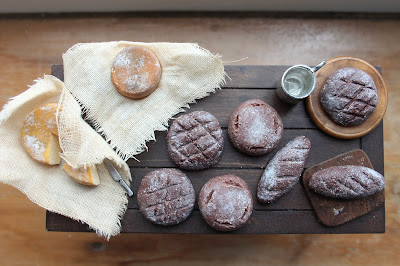Bread. A staple food of so many civilisations. It can be, and is, made with almost any grain you care to imagine. But it can be, and has been throughout history, adulterated with non-grain products along the way if grain proves too expensive! Additives such as clay, alum, chalk, ground bones, potash or pea (vetch) flour!
Cereals germinate and grow well in particular temperature and soil conditions, so there have been marked regional variations in what is cultivated in different areas of the northern hemisphere from earliest times. And man didn't necessarily have to grind locally grown cereals into a flour! After all, millstones could be in short supply if the geology wasn’t right. (I guess they were traded?) Precisely how much time can one afford to dedicate to grinding grain if there are other time consuming chores that must be done to keep body and soul together, to eek out an existence? A coarse bread made from pounded, crushed grain meal would suffice and be just as nutritious, if a little harder wearing on the teeth!
A peasant in Medieval Europe was more likely to use pounded grain in his cooking pot, or make a “mash” or porridge mixed with water, than to bake bread. Buckwheat - which would grow just about anywhere - was a favourite for porridge or pancakes. Or the same peasant might make “maza” an unleavened cereal meal dough paste, thicker than porridge, which could be shaped and baked on a stone in the embers of the fire. In Scotland barley meal used in this way would produce a barley bannock.
The craft of breadmaking was recognised from the 6th Century (the Dark Ages). In the Middle Ages in Medieval society both the master miller and the master baker were allowed to mill or “bolt” flour. Using the lord’s, or the abbot’s grain traded locally.
In fact the word “lord” derives from an Old English word hlaford meaning "master of a household, ruler, superior," and even earlier still from the German word hlafweard, literally "one who guards the loaves," from the word hlaf "bread, loaf". This direct connection is because a lord maintains and feeds his household, and offers hospitality to the traveller. The word lady derives from Old English hlǣfdige, the dige part related to our word dough, which became lady by 1382, and literally means "bread-kneader". The Old English hlafæta is a "household servant," literally "loaf-eater." So “lord” and “lady” both retain vestiges of their original meanings, but as the Free English Dictionary by Farlex remarks - England's aristocrats have not been elbow deep in flour, let alone dough, for several centuries!
By contrast MedievaMorsels has been kneading dough, or more accurately Fimo modeller’s clay!
I have extended the range of period breads for a Dark or Middle Ages dolls house, a Tudor, Renaissance dollhouse or a Colonial, pioneer setting.
But these loaves would look equally at home in a modern dollshouse, rustic dirama or market scene. I have added introduced large rolls, as well as loaves because at a meal, or indeed a feast, the noble company on the top table may well have been served an individual, fine white manchet loaf. Though we may fancifully believe otherwise, bread was in fact a very large part of the upper class, noble diet whilst the humble peasant was not allowed to mill flour or bake bread. If he could not afford to buy it, he and his family would make do with pounded cereal meal added to the family cooking pot.
MedievalMorsels is now on FaceBook! Please visit and "like" if you can!























